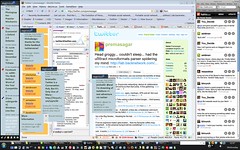 Image via Wikipedia
Image via Wikipedia
How much time is too much?
This is a question I often ask myself when, whilst doing homework, I find myself checking Facebook for the umpteenth time. If you, like me, are unsure of whether or not you are spending too much time on Facebook, then you will find the following helpful:
Five Clues You Are Addicted to Facebook:
1.) You lose sleep over Facebook
2.) You spend more than an hour a day on Facebook
3.) You become obsessed with old loves
4.) You ignore work in favor of Facebook
5.) The thought of getting off Facebook leaves you in a cold sweat
The list above was created by psychologist Lipari, because, believe it or not, psychologists get a significant number of patients coming in for social networking addictions. There are many adults that are starting to neglect the duties of this world in favor of ease and simplicity of the social networking world. I think that at the point where someone can’t function in the real world anymore is the point where a social network becomes a social dysfunction.
Since, I found many items on the list to be a bit extreme for my case, I think a better indicator would be trying to see how long I can go without Facebook. Sometime in the future I’ll try to go a week or so without it, but maybe not just yet…
![Reblog this post [with Zemanta]](http://img.zemanta.com/reblog_a.png?x-id=cdef003f-518e-43e5-b760-8308059dd0e1)

![Reblog this post [with Zemanta]](http://img.zemanta.com/reblog_e.png?x-id=aaed07de-6c8c-4d93-9c3e-fc5942fdb174)
![Reblog this post [with Zemanta]](http://img.zemanta.com/reblog_e.png?x-id=1c35c6d3-9df0-4cae-81a9-db2dcee6acfa)

![Reblog this post [with Zemanta]](http://img.zemanta.com/reblog_e.png?x-id=2622dd3a-3874-4744-a27d-819299ec3722)

![Reblog this post [with Zemanta]](http://img.zemanta.com/reblog_e.png?x-id=30babe09-581a-4512-bceb-b7a74af3150d)

![Reblog this post [with Zemanta]](http://img.zemanta.com/reblog_e.png?x-id=34de5134-acae-49bb-bb62-15b6d8e12643)
 This question is not as simple as it seems, because it varies from user to user. Some may argue that the Second Life Economy is actually more stable because 1 U.S. dollar goes a lot farther in the game than in real life (1 USD = 228 Linden Dollars), and only people spending large amounts of money on the site are trying to cut back. However, the general consensus seems to be that the economy is definitely having a negative impact on Second life spending.
This question is not as simple as it seems, because it varies from user to user. Some may argue that the Second Life Economy is actually more stable because 1 U.S. dollar goes a lot farther in the game than in real life (1 USD = 228 Linden Dollars), and only people spending large amounts of money on the site are trying to cut back. However, the general consensus seems to be that the economy is definitely having a negative impact on Second life spending.
![Reblog this post [with Zemanta]](http://img.zemanta.com/reblog_e.png?x-id=29c402f5-3de9-4088-ab53-bd67f3d2e414)

![Reblog this post [with Zemanta]](http://img.zemanta.com/reblog_e.png?x-id=6d267834-cf2f-499d-a264-e9c0744ba74f)

![Reblog this post [with Zemanta]](http://img.zemanta.com/reblog_e.png?x-id=1024d2a9-c22d-4509-8616-3e4d9320da8b)

![Reblog this post [with Zemanta]](http://img.zemanta.com/reblog_e.png?x-id=380b1cf6-bc62-432a-b52c-3123bdad8161)

![Reblog this post [with Zemanta]](http://img.zemanta.com/reblog_e.png?x-id=ad22573b-4e63-407f-984f-6cd30cdf73bd)